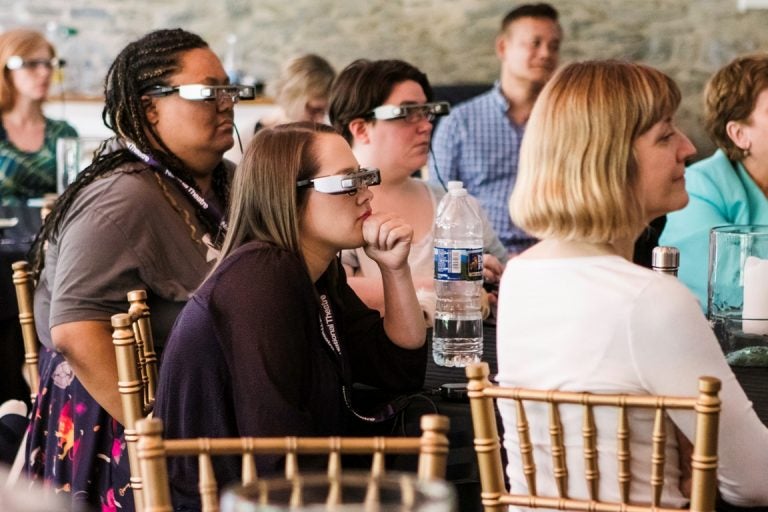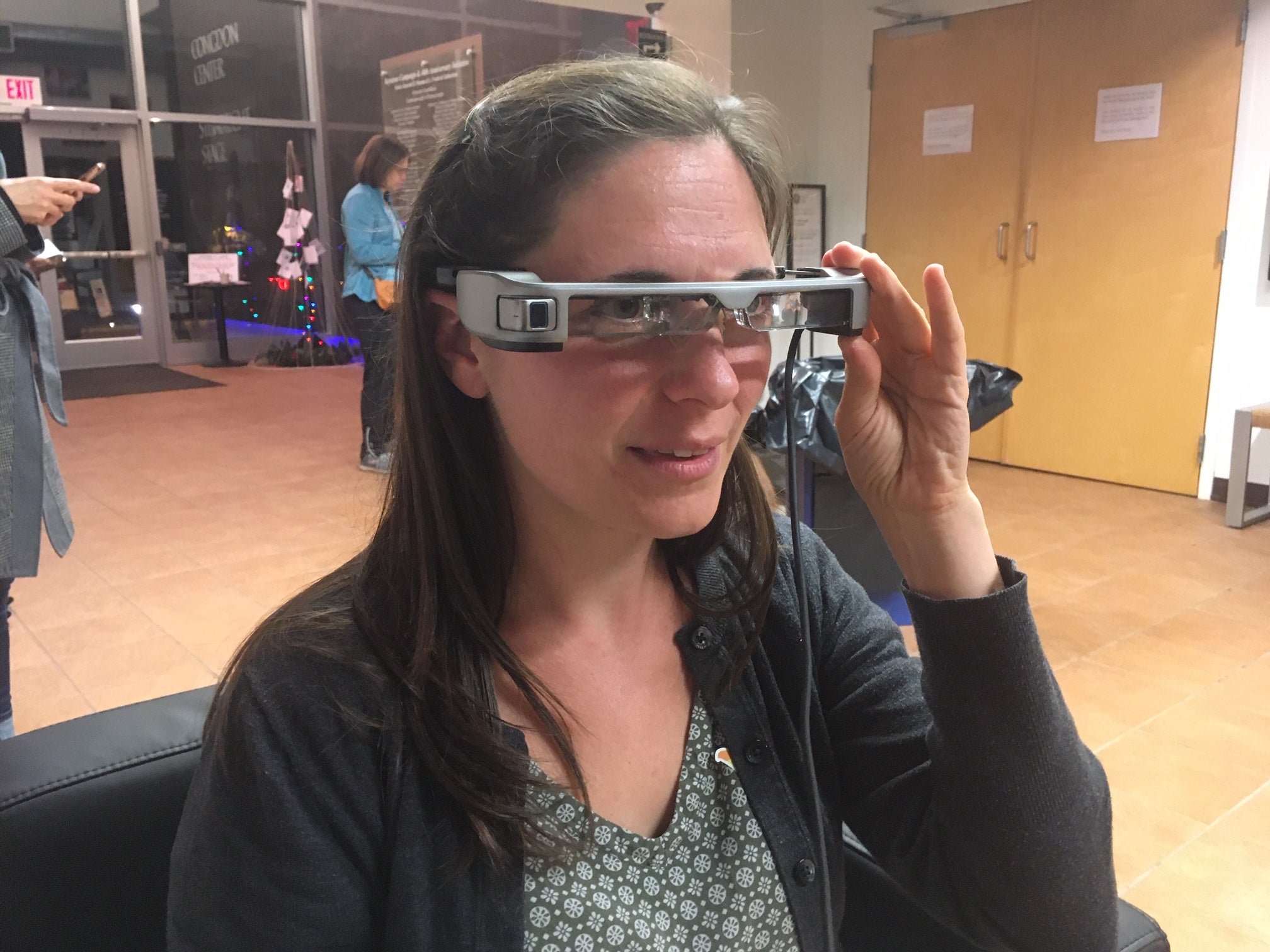Adapted for the stage: Glasses that stream captions in real time improve access for hearing impaired
At People’s Light, a first for the U.S.: tech that times captions to live action and stage delivery that might vary slightly from performance to performance.

People's Light staff tries on the glasses. At the right foreground is Lisa Sonneborn, director of media arts and culture at Temple University's Institute on Disabilities, one of the partners in the project to bring the Smart Caption Glasses to the United States. (Courtesy of People's Light)
High-tech is commonplace in the nation’s theaters: projections that enhance scenery or advance a plot; lasers and lights run by computerized cues; machinery that helps create special effects.
The newest stage technology, being introduced to the United States at People’s Light in Malvern, is a much simpler idea than all that. And it could change the way people see theater.
It’s a pair of glasses, being officially rolled out today, Oct. 17, at a show-and-tell at People’s Light for theater administrators, the press, and others. These are not the 3-D glasses that Hollywood has used, with mixed success, for some time now. They don’t help create a production — they create access to it.
These are closed-caption glasses, with captions that stream in real time as the live action unfolds on stage. For people with hearing impairment, the Americans with Disabilities Act requires movie theaters to have such glasses available for films that don’t already have captions on the screen.
But for theater, the technology has not been available until now to stream captions timed to live action and stage delivery that might vary slightly from performance to performance. The technology began to be developed in 2016, when the National Theatre of Great Britain started working in earnest with a specialist in speech and teleprompt systems, Andrew Lambourne.
Sony had already developed one form for movie theaters, so the glasses themselves were not the hard part. The challenge was developing an algorithm — artificial intelligence that could follow a script as actors speak, and synch the captioning with lighting, sound and movement cues. By October of last year, after working with technicians at Epson to manufacture glasses that work with the newly developed software, the National Theatre launched the Smart Caption Glasses. In February, the glasses became available at all three of the National’s stages.
“It’s been pretty amazing for people who really need the system because we’ve increased people’s choice,” said Jonathan Suffolk, the National’s project director. He has overseen the process, which debuted for the stage company’s productions of “War Horse” and “Hadestown,” whose Broadway production won this year’s Tony Award for Best Musical.
“For those who are profoundly deaf, the glasses are transformative, allowing them to come back to the theater,” Suffolk said. “We’ve had messages from people who hadn’t come to the theater for 25 or 30 years. Thirty percent of the people are coming back over and over again. They’re becoming serial glasses users, which is brilliant.”
Eyeing the local audience
About the same time Suffolk was preparing to introduce the glasses to the National Theatre’s audience, folks at Temple University’s Institute on Disabilities — which focuses on inclusion issues — applied for a Knight Foundation grant, with an eye to bringing the technology to the United States. They were awarded $50,000.
“We knew that People’s Light is really dedicated to creating welcoming programming,” said Lisa Sonneborn, who directs arts initiatives for the institute. “Our values were aligned.”
She and Marcie Bramucci, who directs community projects at People’s Light, “have dreamed and schemed together for the past 18 months.” More grants came through, and they went to London with the heads of People’s Light and the Temple Institute to see the glasses first-hand.
“And they were as cool as we thought they would be,” Sonneborn said.
The National Theatre joined in partnership to bring the glasses here.
Sonneborn and Bramucci talked with people who would be prime users of the glasses, and learned many things about their needs. For instance, “theater foyers can be busy, overwhelming places, and often people are frustrated before they get to the box-office window. What environments could we create that would not make them feel ‘othered?’” Sonneborn said. “Access is a right. It’s one of our core values.”
To that end, People’s Light’s Bramucci said, the new glasses are not a replacement for aids to accessibility already in place. The stage company, like many in the region, has a variety of them, from ASL interpreters to open-caption performances and “relaxed” performances for those who may have problems sitting or responding at the theater.
In the broadest meaning of accessibility, the National Theatre itself is a pioneer: Ten years ago, the company began filming and broadcasting productions to be shown at movie theaters in the United States and elsewhere, making them accessible to a huge new audience outside London.
Tryouts in Malvern

The glasses have been available for the last few weeks in a pilot program at People’s Light for about 50 focus-group members who are helping the Temple institute and the stage company anticipate stumbling blocks in the project and solve them.
The group has worn the glasses while seeing “Dot,” the current People’s Light production.
“One woman put on the glasses — she had a big smile immediately — and said she felt empowered, as if this technology was specifically made for her,” Bramucci said. “She mentioned how meaningful it was that she was able to laugh as others were laughing.
“We had a woman who was blind in one eye, who came last weekend. She plans to use them again,” Bramucci said. “With any of our inclusive offerings, we want the invitation to be as broad as possible. Who knows the reason someone might want to try the glasses?”
In fact, the Smart Caption Glasses might be as useful to audience members with impaired vision as they are to those with impaired hearing. That was my thought as I wore them at a recent performance of “Dot,” Colman Domingo’s engrossing funny/sad play about a West Philadelphia family and its matriarch with increasing signs of dementia.
And the glasses will work with anyone who wants to more easily understand a dialect (particularly true of Irish-play performances), or follow along with Shakespeare, or understand how the actors’ interpretations bring the written word alive.
The glasses are featherweight and easy to use — virtually everything about them is adjustable. You can use them anywhere you sit in the theater. The captions are literally in your face. Once you get used to the lenses, which have slightly darker sections where the captions appear, and the fact that captions move with you whenever your head moves, the rest is easy.
You can choose from six caption colors in the crisp Arial font, raise the captions high or low in your vision (I found that for this staging, they worked well just above the middle of my field), and enlarge them to the size you want. You can wear them over your own prescription glasses. They come attached to a small controller I wore around my neck and forgot about a few minutes into the play.
The downside: Some of “Dot” is performed with rat-a-tat delivery, sometimes with people speaking over one another. In those instances, the algorhithm did not keep up with the pace. Some captions didn’t sync with the delivery from the stage — even if they did, they’d have to flash by so quickly that my head would spin. Other times, the captions flipped off for 10 seconds or so. I’m not sure that would have ruined the experience of someone who needed the glasses, but it would have been noticeable and probably frustrating.
There’s no doubt that the glasses will be attractive to theater industry leaders. They’re potential audience builders. They’re here at a time when the aging baby boom of theatergoers grapples to adjust to sensory changes.
The glasses are comparatively inexpensive for such a project — People’s Light currently owns a dozen at $1,200 a pair, and will offer them beginning with its January show. And they are, as Sonneborn said, cool.
New research will eventually break new ground: real-time translation for audience members who don’t speak the language a play is performed in, and a voice-recognition capability so the glasses work for plays with improvisation, like the daffy pantos that are the People’s Light cash cows at Christmastime.
“The way I see it,” said the National Theatre’s Suffolk, “it’s not perfect. But it’s like the early stages of any technology that offers people incredible freedoms they don’t have at the moment — it’s a beginning, and we’re on an adventure together.”
WHYY is your source for fact-based, in-depth journalism and information. As a nonprofit organization, we rely on financial support from readers like you. Please give today.




